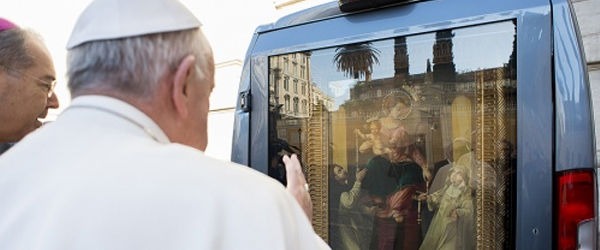The Vatican often makes headlines, never more so than at a time of transition such as that which Pope Benedict XVI ushered in Feb. 11 with the surprise announcement of his resignation.In addition to its frequently prominent place in the news, though, the papacy has, over the years, drawn the occasional attention of the entertainment industry as well.Pontiffs, both real and fictional, have been portrayed — sometimes accurately, sometimes in caricature — on stage, in movies and via television. The highlights of papal history have been used to inspire audiences, while the scandalous patches in that long chronicle have been employed for less edifying ends.As long ago as 1935, for example, French director Abel Gance — perhaps best remembered today for his epic, multi-screen biopic "Napoleon" (1927) — focused on the decadent Renaissance-era reign of Pope Alexander VI in "Lucrezia Borgia." Gance left sufficiently little to viewers' imagination for his film to draw a "Condemned" classification from the National Legion of Decency.Nor, it seems, have Alexander's lusty cavorting gone out of style: Beginning in 2011, Jeremy Irons has been re-enacting them with gusto on Showtime's lurid series "The Borgias."The same network's earlier, more church-friendly (though hardly less carnal) series "The Tudors," featured Peter O'Toole as one of Alexander's successors, the worldly wise but not unsympathetic Paul III.In the 1965 film "The Agony and the Ecstasy," adapted from Irving Stone's historical novel, Rex Harrison played another bishop of Rome whose record jars modern sensibilities: Julius II.As directed by Carol Reed, the picture mainly concerns Michelangelo's (Charlton Heston) exhausting work — undertaken at Julius' behest, and with his often-impatient encouragement — to fresco the ceiling of the Sistine Chapel. But it also shows us Julius' more problematic legacy as the last leader of the church to command troops in battle. Arrayed in full armor, Harrison's Julius rides majestically to the defense of his territory as sovereign of the Papal States.The pontiffs of the modern era have — fortunately — deserved, and generally received, more reverential treatment. Thus the 2002 Italian made-for-television film "Papa Giovanni — Joannes XXIII" (available on DVD, dubbed in English, as "John XXIII: The Pope of Peace") saw Ed Asner portraying the initiator of the Second Vatican Council. Bob Hoskins took on the same role in the following year's "The Good Pope: John XXIII."The eventful life of Karol Wojtyla — both before and after he became Pope John Paul II in 1978 — has been the subject of at least one big-screen docudrama and numerous TV specials. Three years after his distinguished countryman's election, Polish director Krzysztof Zanussi's film "From a Far Country" profiled Wojtyla's youth, with Cezary Morawski playing the future pontiff.At the other end of the reign, 2005, the year of Blessed John Paul's death, brought three small-screen tributes: The four-hour CBS miniseries "Pope John Paul II" starred Jon Voight in the title role; Piotr Adamczyk led the cast of the Hallmark Channel presentation "A Man Who Would Become Pope"; and ABC's "Have No Fear: The Life of John Paul II" featured German born actor Thomas Kretschmann.World War II-era Pope Pius XII has had a more mixed representation. In fact, it was a stage piece, German playwright Rolf Hochhuth's 1963 drama "The Deputy: A Christian Tragedy," that first initiated the controversy over Pius' supposed silence in the face of the Holocaust. Nonetheless, another Italian made-for-TV movie, 2010's "Pius XII," starring James Cromwell, shows how strenuously, if unobtrusively, Pius opposed the Nazi's treatment of Jews.Probably the most famous fictional pope in cinematic history hailed, like the real-life John Paul II, from Eastern Europe. In 1968's "The Shoes of the Fisherman," director Michael Anderson's screen version of Morris L. West's novel, Anthony Quinn played Kiril Lakota, a former political prisoner-turned-pope who resolves to give away the Vatican's wealth.Other made-up pontiffs have found adventure by going on the lam. In "Saving Grace," a 1985 feature helmed by Robert M. Young, Tom Conti's unusually young Pope Leo XIV turns the accident of being locked out of the Vatican to pastoral advantage by ministering to everyday people.Italian director Nanni Moretti's 2011 screen fable "We Have a Pope" ("Habemus Papam") involves a similar journey undertaken in very different circumstances: After suffering an emotional meltdown shortly after his election, the film's newly minted and as-yet-unnamed bishop of Rome, played by Michel Piccoli, escapes from the Vatican and takes to the streets of the Eternal City in search of spiritual bolstering.Unlike at least some of his historical counterparts, alas, he fails to find it.John Mulderig is on the staff of Catholic News Service.{gallery width=100 height=100}gallery/2013/0315/papacyfilms/{/gallery}

